Vaccine Types
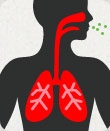
Pertussis (Whooping Cough)
What is it?
Pertussis (Whooping Cough) is a highly contagious respiratory tract infection that is most severe in infants and young children. While it may seem like an ordinary cold at first, pertussis causes uncontrollable, sometimes violent coughing spells and can lead to pneumonia, seizures, brain damage and death. Pertussis is spread when an infected person coughs or sneezes. After the bacteria infect someone, symptoms do not appear until about 7 -14 days later and usually last 6 - 10 weeks. Pertussis is marked by the “whoop” sound infected persons make when air is inhaled following coughing spells. Hear what pertussis sounds like.
Why is it important?
Reported cases of pertussis nationwide are at the highest level in 50 years. In 2012, there were 1,505 reported cases of pertussis in Colorado -- the highest in 64 years. The epidemic continued into 2013, with 1,458 cases reported in Colorado. Over the past five years, Colorado has averaged 324 cases per year. While pertussis cases are high across the country, Colorado’s rate exceeds the national rate. If there was ever a time to make pertussis vaccination a priority, now is it.
Pertussis affects people of all ages, but it is most common and most severe in infants and young children. Infants cannot be vaccinated against pertussis until two months of age and do not have substantial protection until at least 6 months of age after they have received three doses of DTaP. More than half (57%) of infants younger than one year who contract pertussis are hospitalized. Complications in infants can include apnea (slowed or stopped breathing), pneumonia, need for assisted ventilation, convulsions (violent, uncontrolled shaking), encephalopathy (disease of the brain) or death. Approximately 1-2% of infants who get the infection will die from it.
Older children, adolescents, pregnant women and adults need protection from this disease too. Pertussis is different from other illnesses because many infants and children who get it are infected by an older sibling, parent or caregiver who might not know they have pertussis. It is estimated that every year in the United States between 600,000 and 900,000 adults and adolescents get pertussis. Teens and adults can also get complications from pertussis, but they are usually less serious, and include prolonged cough, passing out, or rib fractures from severe coughing.
Progress
Before the vaccine was introduced in the 1940s, about 147,000 U.S. children came down with whooping cough every year. Following the introduction of the vaccine, the number of cases in the U.S. dropped to an historic low of 1,010 in 1976. However, there has been a steady spike in the number of cases during the past three decades. Experts say there are several factors that may explain why Colorado and other states are experiencing a pertussis epidemic, including increased awareness (resulting in more testing), changes in bacteria strains and waning immunity.
Although it is effective, the pertussis vaccine is not perfect. Changes in vaccine composition may partly explain current whooping cough outbreaks in the United States and Australia. It's possible that the newer, current vaccine is less effective and wears off faster. This does not change the fact that the best way to prevent whooping cough is to get vaccinated. Those who do develop whooping cough despite being vaccinated experience milder symptoms and are less infectious. Studies have shown that children not vaccinated are 23 times more likely to get pertussis than those who are fully vaccinated.
Vaccine Recommendations
The DTaP vaccine prevents three diseases with one shot: diphtheria, tetanus, and pertussis. Children should get five doses of DTaP vaccine, one dose at each of the following ages:
- 2 months
- 4 months
- 6 months
- 15-18 months
- 4-6 years
Anyone who comes in contact with a baby – parents, grandparents, caregivers, siblings, plus extended family and friends – should receive the adult form of the vaccine (Tdap) to help shield or "cocoon" newborns from whooping cough. It is also recommended that pregnant women receive a Tdap vaccine during each pregnancy between weeks 27 and 36 to benefit mother and baby. When a mom-to-be is vaccinated, she passes disease-fighting antibodies onto her baby to help protect him or her after birth.
Side Effects
While the risk of DTaP vaccine causing serious allergic reaction is very small (about 1 in 1 million) common side effects of this vaccine may include:
- Fever (up to about 1 child in 4)
- Redness or swelling where the shot was given (up to about 1 child in 4)
- Soreness or tenderness where the shot was given (up to about 1 child in 4)
Other mild problems include:
- Fussiness (up to about 1 child in 3)
- Tiredness or poor appetite (up to about 1 child in 10)
- Vomiting (up to about 1 child in 50)
These problems generally occur 1-3 days after the shot.
Moderate problems may include seizure (1 in 14,000), crying for 3+ hours (1 in 1,000), or high fever (1 in 16,000).
Influenza
Influenza
Influenza (flu) is a highly contagious viral upper respiratory illness. Flu may be complicated by other risk factors, including pneumonia. [+] more
|
Hepatitis B
Hepatitis B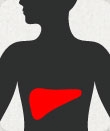
Hepatitis B virus (HBV) affects the liver and is primarily spread through blood and bodily fluids. Acute HBV infection can lead to chronic HBV and liver damage. [+] more
|
Polio
Polio
Poliomyselitis (polio) is an extremely contagious viral infection that affects the nerve cells of the brain stem and spinal cord and can lead to paralysis. [+] more
|
Diphtheria
Diphtheria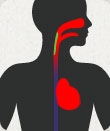
Diphtheria is a bacterial respiratory illness that causes a thick covering in the back of the throat, leading to breathing problems, paralysis, or heart failure. [+] more
|
Rotavirus
Rotavirus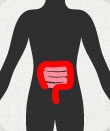
Rotavirus is a viral infection of the digestive track, and is the most common cause of severe diarrhea and vomiting in infants and young children. [+] more
|
Pneumococcal
Pneumococcal
Pneumococcal bacteria live in noses and throats of people of all ages. Pneumococcus can infect the middle ear, sinuses, lungs, central nervous system and bloodstream. [+] more
|
Measles
Measles
Measles is a highly contagious viral respiratory infection that causes a total-body skin rash and flu-like symptoms. [+] more
|
Mumps
Mumps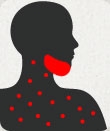
Mumps is a highly contagious viral infection that can affect many parts of the body. The hallmark sign of mumps is swelling of the salivary glands. [+] more
|
Rubella
Rubella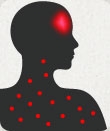
Rubella (German measles) is a contagious viral disease that can cause fever, rash, swollen glands and arthritis. Infection during pregnancy can lead to birth defects. [+] more
|
Tetanus
Tetanus
Tetanus (Lockjaw) is a bacterial infection that affects the nervous system and causes painful tightening of the muscles all over the body. It is spread through contact with contaminated surfaces. [+] more
|
Pertussis (Whooping Cough)
Pertussis (Whooping Cough)
Pertussis (Whooping Cough) is a highly contagious bacterial respiratory disease. Pertussis causes violent coughing spells that make it hard to eat, drink or breathe, and is especially severe in young infants. [+] more
|
Chickenpox
Chickenpox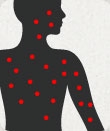
Varicella (Chickenpox) is a highly contagious viral infection characterized by a blistering rash that can cover the entire body. Complications include skin infections, pneumonia and brain swelling. [+] more
|
Hepatitis A
Hepatitis A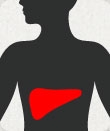
Hepatitis A (HAV) virus attacks the liver, and is spread through stool of an infected person by direct contact or by contaminated food or drink. [+] more
|
Meningococcal
Meningococcal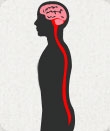
Meningococcal disease is a severe bacterial infection that causes inflammation of the membranes covering the brain and spinal cord (bacterial meningitis) and blood poisoning (septicemia), and requires immediate medical attention. [+] more
|
Hib
Hib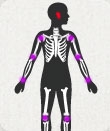
Haemophilus influenza type b (Hib) bacterium can infect a child’s skin, joints, bones and ears. Hib can lead to a variety of infections including pneumonia, bacteremia, and meningitis. [+] more
|
HPV
HPV
Human Papillomavirus (HPV) is the most common sexually transmitted virus in the United States. About 40 types of HPV can infect the genital areas of males and females. A few types can lead to cervical and other cancers. [+] more
|




